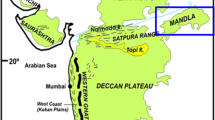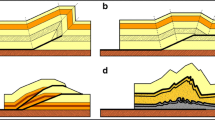Abstract
Through the application of remote sensing techniques followed by field checks, the exact extension and nature of Suruli shear zone in Madurai block of southern granulite terrain (SGT) in south India is brought out for the first time in this work. The dominant rock type exposed in this area is charnockite intruded by granites. The Suruli ductile shear zone extends from just west of Kadaiyanallur in the south to Ganguvarpatti in the north over a length of 150 km. Between Kadaiyanallur and Kambam, the shear zone extends roughly in N-S direction. From Kambam, it swerves towards NE and then towards ENE near Ganguvarpatti. The strongly developed transposed foliation and mylonite foliation within the shear zone dip towards east only and so the eastern block (Varushanad hills) is the hanging wall and the western block (Cardamom hills) is the footwall of the shear zone. In the eastern block, three distinct phases of regional scale folding (F1, F2 and F3) are recognized. In complete contrast, the western block recorded only the last phase (F3) regional scale folding. As the more deformed eastern block (older terrain) moved over the relatively less deformed western block (younger terrain) along the Suruli shear zone, it is proposed that this shear zone is a thrust or reverse fault, probably of Proterozoic age. As there are evidences for decreasing displacement from north to south (i.e., from Ganguvarpatti to Kadaiyanallur), the Suruli shear zone could be a rotational thrust or reverse fault with the pivot located close to Kadaiyanallur. As the pivot is located near Achankovil shear zone which trends WNW-ESE (dip towards SSW), the Suruli shear zone could be splaying (branching) out from Achankovil shear zone. In a nutshell, the Suruli shear zone could be a splay, rotational thrust or reverse fault.
Similar content being viewed by others
References
Balakrishnan P, Bhattacharya S and Anil Kumar 1985 Carbonatite body near Kambammettu, TN; J. Geol. Soc. India 26 418–421.
Balasubramanian E and Sundarrajan P 1997 Geology of Cumbam lineament zone around Periakulam within the structural conjunction zones in parts of Madurai Dist., TN; Geological Survey of India Field Season 1993–1994.
Chetty T R K 1995 Structural interpretation of high grade belts of south India using remotely sensed data; NMRMS Bulletin 19 34–37.
Chetty T R K 1996 Proterozoic shear zones in Southern Granulite Terrain; Memoir Gond. Res. Gr. 3 77–89.
Drury S A and Holt R W 1980 The tectonic framework of the south Indian craton — a reconnaissance involving LANDSAT imagery; Tectonophys. 65 T1–T15.
Drury S A, Harris N B W, Holt R W, Reeves Smith G J and Wightman R T 1984 Precambrian tectonics and crustal evolution in south India; J. Geol. 92 3–20.
Francis Anto K, Janardhan A S and Siva Subaramanian P 1997 A new sapphirine occurrence from Kambam valley, TN and its possible relation to Pan-African tectono thermal event; Curr. Sci. 73 792–796.
Gopalakrishnan K, Sugavanam E B and Venkata Rao V 1975 Are there rocks older than Dharwars? A reference to rocks in Tamil Nadu; Ind. Mineralogist 16 26–34.
Grady J C 1971 Deep main faults in South India; J. Geol. Soc. India 12 56–62.
GSI 2006 A manual of the Geology of India; Geol. Sur. India Spec. Publ. 77(1,1) 346–486.
Guru Rajesh K and Chetty T R K 2006 Structure and tectonics of Achankovil shear zone, southern India; Gondwana Res. 10 86–98.
Harris N B W and Santosh M 1993 Chronological constraints on granulite formation in southern India and Sri Lanka; Geol. Soc. India Memoir 25 361–379.
Harris N B W, Santosh M and Taylor P N 1994 Crustal evolution in South India: Constraints from Nd isotopes; J. Geol. 102 139–150.
Rajeshdurai P, Srinivasan V and Swain A K 2008 Metamorphic evolution of granulites around Rajapalayam area, Madurai Block, Southern Granulite Terrain, Tamil Nadu; Geol. Surv. India Spec. Publ. 91 45–60.
Sanjeevi S and Aparna S Bhaskar 2008 Satellite derived Digital terrain and perspective models. An aid to teach geological mapping; J. Geol. Soc. India 71 214–222.
Santosh M 1996 The Trivandrum and Nagercoil granulite blocks; In: The Archaean and Proterozoic terrains in southern India within East Gondwana; Gond. Res. Gr. Memoir 3 243–356.
Srinivasan V and Rajeshdurai P 2009 Study of the granulite and associated rocks of Rajapalayam-Sankarankovil area of Southern Granulite Belt; Geol. Surv. India Field Season 2006-07, 2007-08.
Sundaravanan D 2003 Study of the southern continuity of Suruli Ar lineament in Kambam valley, Teni Dist., TN; Geol. Surv. India, Field Season 1999–2000.
Sundaravanan D and Baskaran R 1998 Report on the study of Vaigai lineament zone around Vattalagundu within structural conjunction zones in parts of Madurai and Dindigul Anna districts, TN; Geol. Surv. India, Field Season 1994–1995.
Sundaravanan D and Mullaivendan T 1997 Study of Kambam lineament zone around Chinnamanur within structural conjunction zones in parts of Madurai Dist., TN; Geol. Surv. India, Field Season 1993–1994.
Sundaravanan D and Sundarrajan P 1999 Study of the structural conjunction zone around Ganguvarpatti and the lineament zone around Sakkanurani in parts of Dindigul and Madurai districts, TN; Geol. Surv. India, Field Season 1995–1996.
Author information
Authors and Affiliations
Corresponding author
Rights and permissions
About this article
Cite this article
Srinivasan, V., Rajeshdurai, P. The Suruli shear zone and regional scale folding pattern in Madurai block of Southern Granulite Terrain, south India. J Earth Syst Sci 119, 147–160 (2010). https://doi.org/10.1007/s12040-010-0011-z
Received:
Revised:
Accepted:
Published:
Issue Date:
DOI: https://doi.org/10.1007/s12040-010-0011-z




